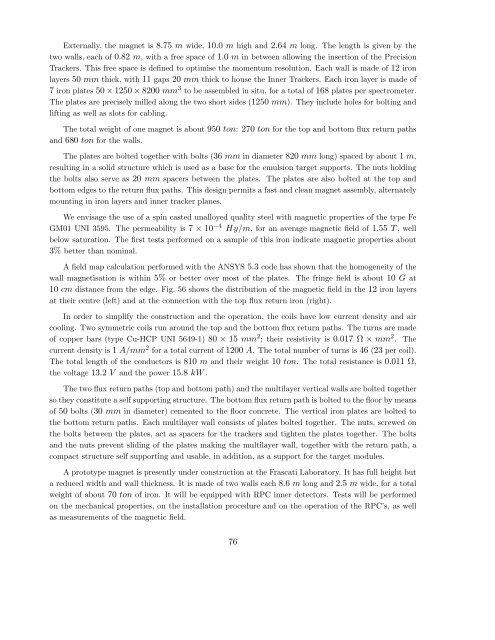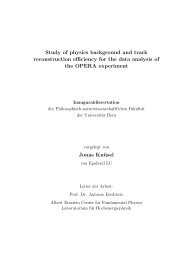Experiment Proposal - opera - Infn
Experiment Proposal - opera - Infn
Experiment Proposal - opera - Infn
Create successful ePaper yourself
Turn your PDF publications into a flip-book with our unique Google optimized e-Paper software.
Externally, the magnet is 8.75 m wide, 10.0 m high and 2.64 m long. The length is given by the<br />
two walls, each of 0.82 m, withafreespaceof1.0 m in between allowing the insertion of the Precision<br />
Trackers. This free space is defined to optimise the momentum resolution. Each wall is made of 12 iron<br />
layers 50 mm thick, with 11 gaps 20 mm thick to house the Inner Trackers. Each iron layer is made of<br />
7 iron plates 50 × 1250 × 8200 mm 3 to be assembled in situ, for a total of 168 plates per spectrometer.<br />
The plates are precisely milled along the two short sides (1250 mm). They include holes for bolting and<br />
lifting as well as slots for cabling.<br />
The total weight of one magnet is about 950 ton: 270 ton for the top and bottom flux return paths<br />
and 680 ton for the walls.<br />
The plates are bolted together with bolts (36 mm in diameter 820 mm long) spaced by about 1 m,<br />
resulting in a solid structure which is used as a base for the emulsion target supports. The nuts holding<br />
the bolts also serve as 20 mm spacers between the plates. The plates are also bolted at the top and<br />
bottom edges to the return flux paths. This design permits a fast and clean magnet assembly, alternately<br />
mounting in iron layers and inner tracker planes.<br />
We envisage the use of a spin casted unalloyed quality steel with magnetic properties of the type Fe<br />
GM01 UNI 3595. The permeability is 7 × 10 −4 Hy/m, for an average magnetic field of 1.55 T ,well<br />
below saturation. The first tests performed on a sample of this iron indicate magnetic properties about<br />
3% better than nominal.<br />
A field map calculation performed with the ANSYS 5.3 code has shown that the homogeneity of the<br />
wall magnetisation is within 5% or better over most of the plates. The fringe field is about 10 G at<br />
10 cm distance from the edge. Fig. 56 shows the distribution of the magnetic field in the 12 iron layers<br />
at their centre (left) and at the connection with the top flux return iron (right).<br />
In order to simplify the construction and the <strong>opera</strong>tion, the coils have low current density and air<br />
cooling. Two symmetric coils run around the top and the bottom flux return paths. The turns are made<br />
of copper bars (type Cu-HCP UNI 5649-1) 80 × 15 mm 2 ; their resistivity is 0.017 Ω × mm 2 . The<br />
current density is 1 A/mm 2 for a total current of 1200 A. The total number of turns is 46 (23 per coil).<br />
The total length of the conductors is 810 m and their weight 10 ton. The total resistance is 0.011 Ω,<br />
the voltage 13.2 V and the power 15.8 kW .<br />
The two flux return paths (top and bottom path) and the multilayer vertical walls are bolted together<br />
so they constitute a self supporting structure. The bottom flux return path is bolted to the floor by means<br />
of 50 bolts (30 mm in diameter) cemented to the floor concrete. The vertical iron plates are bolted to<br />
the bottom return paths. Each multilayer wall consists of plates bolted together. The nuts, screwed on<br />
the bolts between the plates, act as spacers for the trackers and tighten the plates together. The bolts<br />
and the nuts prevent sliding of the plates making the multilayer wall, together with the return path, a<br />
compact structure self supporting and usable, in addition, as a support for the target modules.<br />
A prototype magnet is presently under construction at the Frascati Laboratory. It has full height but<br />
a reduced width and wall thickness. It is made of two walls each 8.6 m long and 2.5 m wide, for a total<br />
weight of about 70 ton of iron. It will be equipped with RPC inner detectors. Tests will be performed<br />
on the mechanical properties, on the installation procedure and on the <strong>opera</strong>tion of the RPC’s, as well<br />
as measurements of the magnetic field.<br />
76




